If you’re new to cooking with a rice cooker, you may be wondering if the bubbling that occurs during the cooking process is normal. The short answer is yes, a rice cooker is supposed to bubble.
When you add water and rice to a rice cooker, the machine uses steam to cook the rice, and bubbles form as the water boils. This is similar to what happens when you cook rice on a stove top but with much less guesswork involved.
However, it’s important to note that excessive bubbling and boiling over can be a sign of a problem. If your rice cooker is spilling over, it could be an indication that you’ve added too much water or rice, or that the cooker needs to be cleaned.
If you’re still unsure whether your rice cooker is working correctly, keep reading for more information on the inner workings of a rice cooker and what to expect during use.
Key Takeaways:
- A rice cooker is supposed to bubble during the cooking process.
- Excessive bubbling and boiling over can be a sign of a problem.
- Keep reading for more information on the mechanics of a rice cooker and what to expect during use.
How a Rice Cooker Works
Before delving into whether or not a rice cooker is supposed to bubble, let’s first understand how a rice cooker works. A rice cooker consists of an inner pot, typically made of metal or non-stick material, and an outer vessel that houses heating elements and controls.
To cook rice in a rice cooker, one simply has to add the desired amount of rice, water, and any additional seasonings or flavors. Once the cooker is turned on, it begins to heat the water in the pot, causing it to boil and produce steam. This steam then rises to the top of the pot, where it cooks the rice evenly and thoroughly.
The key to a successful rice cooking experience is to maintain the proper level of water in the pot. Most rice cookers have markings on the inside indicating the appropriate water level for different types of rice. The water level is essential for ensuring the rice is fully cooked, while preventing it from becoming too soft or sticky.
Rice cooker steam is what cooks the rice, and this is why it is important to keep the lid on the cooker while it is in use. The steam must be sealed inside the cooker to ensure it is evenly dispersed throughout the pot, cooking the rice from all angles.
Overall, the mechanics of a rice cooker are relatively simple but highly effective. By using steam to cook rice, a rice cooker eliminates the need for constant monitoring and manual adjustments, making it an efficient and convenient appliance for any kitchen.
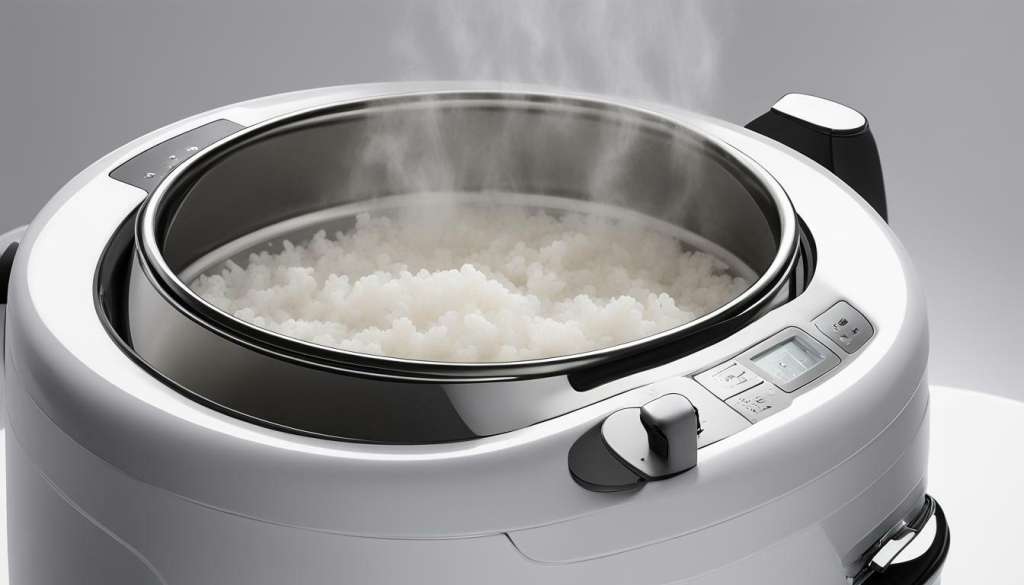
The Bubble Effect: Normal or Not?
Seeing your rice cooker bubble and foam may be alarming, but it’s actually a normal part of the cooking process. As the water in the cooker heats up and reaches boiling point, it creates steam, which in turn causes the bubbling effect. This steam helps the rice to cook evenly and thoroughly.
However, excessive bubbling and foaming can be a cause for concern. If your rice cooker is boiling over or producing too much foam, it may indicate that you’ve added too much water. In this case, try reducing the amount of water you add and see if this solves the problem.
If your rice cooker continues to boil over or foam excessively, another issue could be at play. A damaged or cracked lid can cause steam to escape and lead to increased bubbling and foaming. Check the lid for any signs of damage and replace it if necessary.
Another cause of excessive bubbling and foaming is using low-quality rice. Rice that is too starchy can create too much foam and cause boiling over. Try using a higher quality rice, or rinse the rice thoroughly before cooking to reduce starch content.
To prevent boiling over and excessive foam, make sure you’re using the correct rice-to-water ratio and that you’re not lifting the lid during the cooking process. Lifting the lid can release steam and cause bubbling to increase.
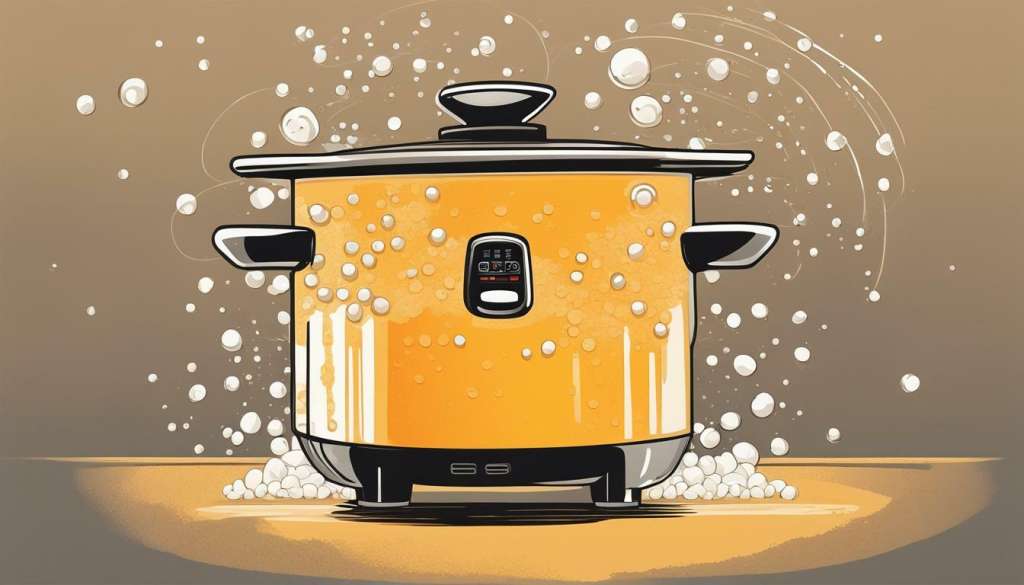
Overall, seeing your rice cooker bubble and foam is completely normal, and is actually a sign that the rice is cooking properly. However, if excessive bubbling and foaming occurs, it may be time to investigate and make some adjustments to ensure your rice is cooked to perfection every time.
Troubleshooting Common Issues
Even with proper use, rice cooker issues may still arise. However, most problems can be easily resolved with some troubleshooting tips.
Rice Sticking to the Bottom: This issue can be avoided by making sure the bottom of the cooking pot is clean before use. Another tip is to add a small amount of oil or non-stick cooking spray before adding the rice and water.
Uneven Cooking: To ensure even cooking, avoid stirring the rice while it is cooking. If uneven cooking persists, try adding more water or using a different type of rice.
Cooker Not Turning On: Check if the power cord is properly plugged in and the outlet is working. If the issue persists, there may be an internal problem and the cooker will need to be repaired or replaced.
For more complex issues, consult the rice cooker manual or contact the manufacturer for assistance.
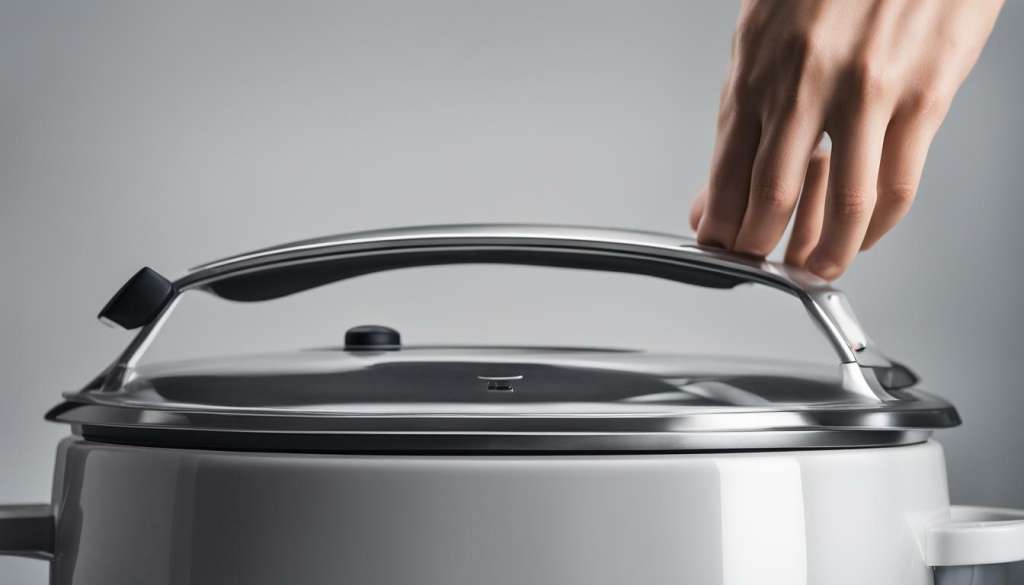
If you need more information about rice cooker troubleshooting, check out our article on Rice Cooker Repair 101.
Maintaining Your Rice Cooker
Proper maintenance of your rice cooker is crucial for ensuring its longevity and optimal performance. Here are some tips to keep your rice cooker in top condition:
| Task | Frequency |
|---|---|
| Regular Cleaning | After every use |
| Descaling | Once a month |
| Replacing Inner Pot | As needed |
Regular cleaning is essential to prevent any buildup of rice starch, which can affect the cooker’s performance. Use a soft sponge or cloth with a mild detergent to clean the inner pot and other removable parts. Avoid using abrasive cleaners that can scratch the surface and damage the non-stick coating.
Descaling is necessary to remove any mineral buildup inside the rice cooker. Use a solution of equal parts water and vinegar and let it sit for an hour before wiping it clean.
If your inner pot starts to show signs of wear and tear, such as scratches or discoloration, it may be time to replace it. Most rice cooker manufacturers offer replacement parts that are easily available online or at a local store.
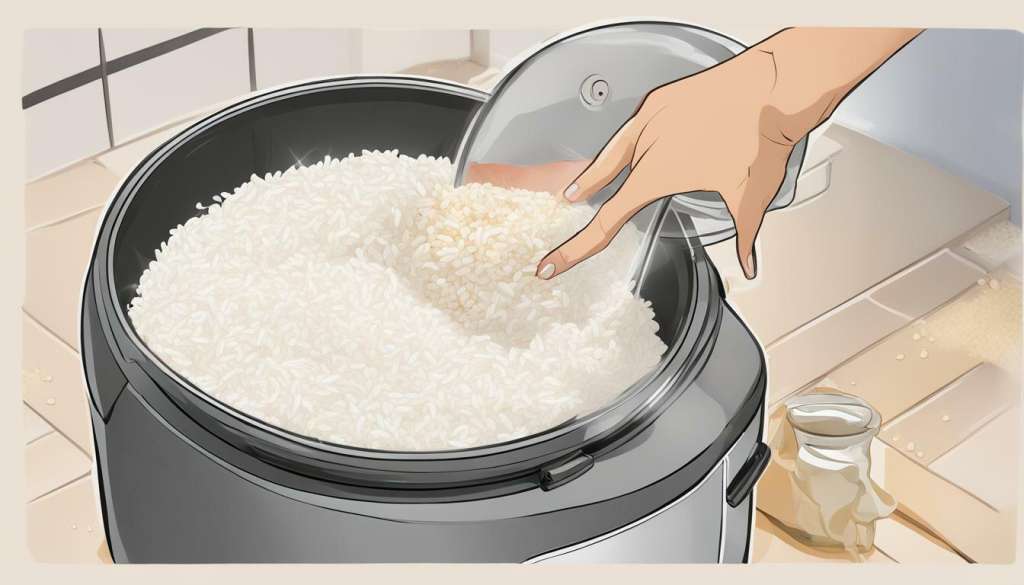
By following these maintenance tips, your rice cooker will deliver perfectly cooked rice for years to come.
Achieving Perfectly Cooked Rice
While a rice cooker is designed to simplify the process of cooking rice, getting perfectly cooked rice requires a bit of finesse. Follow these tips to ensure your rice comes out perfectly every time.
Rice-to-Water Ratio
One of the most critical factors in achieving perfectly cooked rice is the ratio of rice to water. The general rule is to use a 1:2 ratio of rice to water, but this can vary depending on the type of rice you are using. For example, brown rice typically requires more water than white rice, and some varieties of rice, like Basmati, may require less water. Be sure to check the instructions on the rice packaging to determine the appropriate ratio.
Choosing the Right Rice
The type of rice you use can also affect the cooking time and water requirements. For example, sticky rice requires less water and a shorter cooking time than long-grain rice. Some rice cookers come with different settings for different types of rice, so be sure to check your manual to see what options are available.
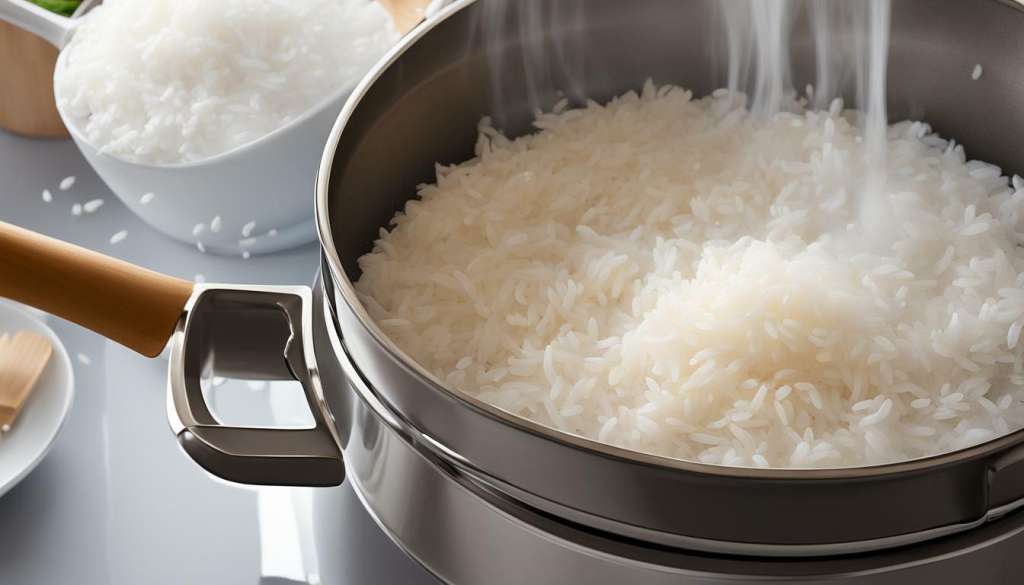
Adjusting Cooking Times
If you find that your rice is consistently under or overcooked, it may be necessary to adjust the cooking time. Most rice cookers have a simple “on/off” switch, but some models come with additional cooking settings or “fuzzy logic” technology that adjusts the cooking time based on the moisture level of the rice. Experiment with different cooking times and settings to find what works best for your rice cooker and preferences.
Experiment with Flavors
Don’t be afraid to add some flavor to your rice! Consider adding herbs, spices, or even coconut milk to the water before cooking to infuse the rice with flavor. Some rice cookers also come with a steamer basket, allowing you to cook vegetables or meat at the same time as your rice for a complete meal.
With proper attention to rice-to-water ratio, rice type, cooking times, and flavor experimentation, your rice cooker can deliver perfectly cooked rice each time, making it an essential kitchen appliance you never knew you needed!
Rice Cooker Accessories and Features
A rice cooker is a versatile kitchen appliance that not only cooks rice to perfection but also comes with a variety of accessories and features to enhance the cooking experience. Here are some of the most popular rice cooker accessories and features:
Steaming Basket
A steaming basket is a popular accessory that comes with most rice cookers. It allows you to steam vegetables, seafood, and other foods while your rice cooks. This not only saves time but also maximizes the use of your rice cooker. You can even steam a whole meal at once!
Delay Timer
A delay timer allows you to set your rice cooker to start cooking at a specific time, so your rice is ready when you need it. This feature is especially helpful when you have a busy schedule and don’t have time to monitor the cooking process.
Automatic Keep-Warm Setting
Most rice cookers come with an automatic keep-warm setting that keeps your rice warm and fresh for hours after it’s done cooking. This feature is great for those who want to prepare their rice earlier in the day or for a large meal.
Multi-Cooker Functionality
Some rice cookers come with multi-cooker functionality, meaning they can also be used to cook other dishes such as soup, stew, and chili. This is a great option for those who want a single appliance that can handle a variety of cooking tasks.
Non-Stick Inner Pot
A non-stick inner pot is a popular feature of rice cookers that makes cleaning up a breeze. It prevents rice from sticking to the pot, and you can easily wipe it clean when you’re done cooking.
Extra Capacity
If you have a large family or regularly host dinner parties, you may want to consider a rice cooker with extra capacity. This will allow you to cook larger quantities of rice at once, so you don’t have to keep refilling the pot.
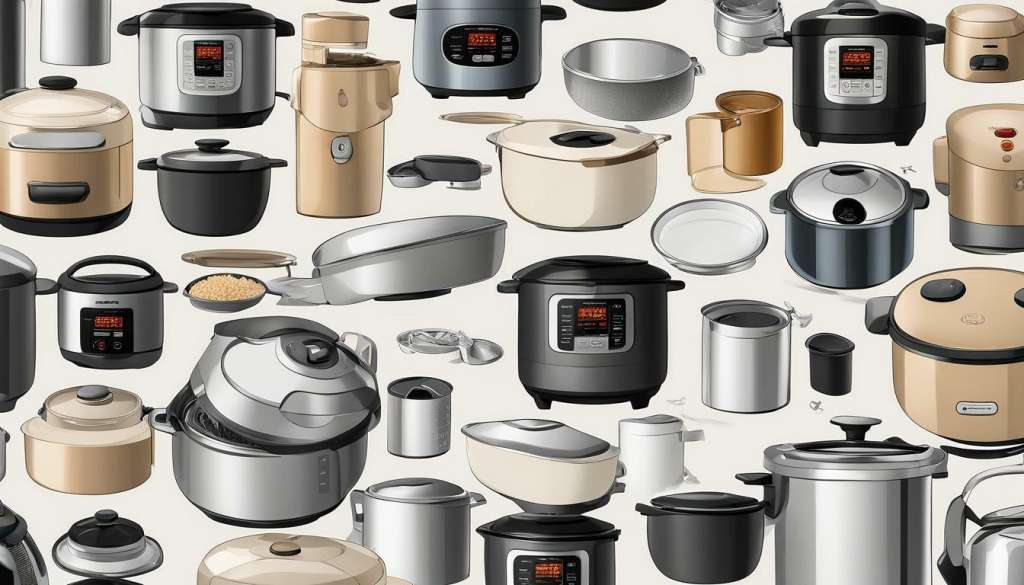
These are just a few of the many accessories and features that come with rice cookers. When choosing a rice cooker, make sure to consider which features are most important to you based on your cooking needs and preferences.
Rice Cooker Tips and Tricks
While rice cookers are primarily designed to cook rice, they can also be used for a variety of other dishes, from steaming vegetables to making soups and stews. Here are some tips and tricks to get the most out of your rice cooker:
1. Make oatmeal
Did you know you can actually cook oatmeal in a rice cooker? Simply add oats and water or milk to the cooker, set it to the porridge setting, and let it cook until the oats are tender. You can even add in your favorite toppings, like nuts, fruit, or honey, for a delicious breakfast.
2. Steam vegetables
Rice cookers often come with a steaming basket, which is perfect for cooking vegetables. Simply place your chopped veggies in the basket, add water to the cooker, and let the steam cook them to perfection.
3. Cook pasta
Yes, you can even cook pasta in a rice cooker! Just add the pasta and enough water to cover it, set the cooker to the porridge setting, and let it cook until al dente. Drain any excess liquid and add your favorite sauce.
4. Make soup or stew
Some rice cookers also come with a slow-cook function, which is ideal for making soups and stews. Simply add your ingredients to the cooker, set it to the slow-cook setting, and let it simmer until everything is cooked to perfection.
5. Keep food warm
Rice cookers often have an automatic keep-warm setting, which is perfect for keeping your food at the right temperature until you are ready to eat. This is especially helpful when entertaining or preparing a meal ahead of time.
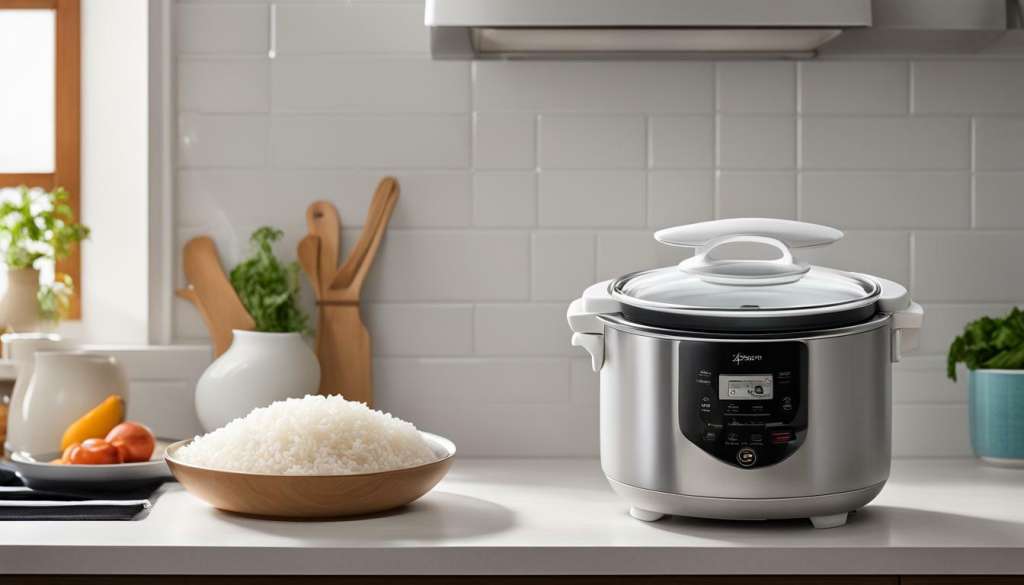
By using these tips and tricks, you can get the most out of your rice cooker and create a variety of delicious dishes. So, next time you’re thinking about making rice, consider what else you could cook in your trusty rice cooker!
Choosing the Right Rice Cooker
Choosing the right rice cooker can make all the difference in your cooking experience. With so many options available, it can be overwhelming to decide which one to buy. Here are some factors to consider when selecting the right rice cooker:
- Capacity: Consider how much rice you typically cook and choose a rice cooker that can accommodate that amount. Rice cookers come in various sizes, ranging from 3 cups to 10 cups.
- Cooking Functions: Some rice cookers come with additional cooking functions, such as steaming vegetables or cooking soups. Consider what functions you need in addition to cooking rice.
- Budget: Rice cookers come in a range of prices. Determine how much you are willing to spend and stick to your budget.
Keep in mind that a higher-priced rice cooker may have more features, but it won’t necessarily make better rice. It’s important to choose a rice cooker that meets your needs and fits within your budget.
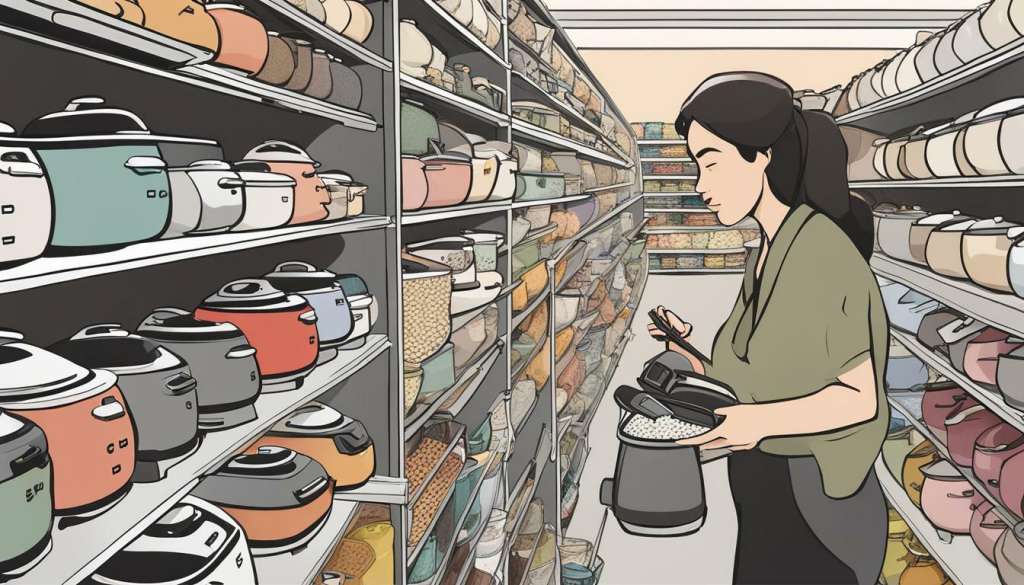
Another important factor to consider is the brand. Look for brands with good reviews and a reputation for producing quality products. Consider reading customer reviews to get an idea of the pros and cons of different brands and models.
Ultimately, the right rice cooker for you will depend on your individual needs and preferences. By considering the factors mentioned above, you can make an informed decision and choose a rice cooker that will make your cooking experience enjoyable and hassle-free.
Safety Precautions
Using a rice cooker is a convenient way to cook rice, but it’s important to follow safety precautions to avoid accidents and injuries. Here are some tips to keep in mind while using your rice cooker:
- Read the manual: Before using your rice cooker, make sure to read the manual thoroughly. This will help you understand how to use your rice cooker safely and efficiently.
- Place the rice cooker on a stable surface: Make sure to place your rice cooker on a stable and flat surface to prevent it from falling over or spilling hot water or rice.
- Keep the rice cooker away from children: Since the rice cooker contains hot water and can be very hot to the touch, it’s important to keep it away from children and pets.
- Do not touch the rice cooker with wet hands: Never touch the rice cooker with wet hands as it can cause electrical shock. Dry your hands thoroughly before using the rice cooker.
- Do not open the lid while cooking: While cooking, do not open the lid of the rice cooker. Opening the lid can cause steam and hot water to escape, which can cause burns and injuries.
- Unplug the rice cooker when not in use: Make sure to unplug the rice cooker when you’re not using it. This will prevent any accidents and also save energy.
- Do not immerse the base in water: To clean the rice cooker, make sure to unplug it and wipe the outside with a damp cloth. Do not immerse the base of the rice cooker in water.
- Handle the inner pot with care: The inner pot of the rice cooker can be very hot after cooking. Use oven mitts or potholders to remove the pot from the rice cooker.
- Be careful when cleaning: When cleaning the rice cooker, be careful not to get water inside the heating element. This can cause damage to the rice cooker and also cause a safety hazard.
By following these safety precautions, you can ensure a safe and enjoyable cooking experience with your rice cooker.
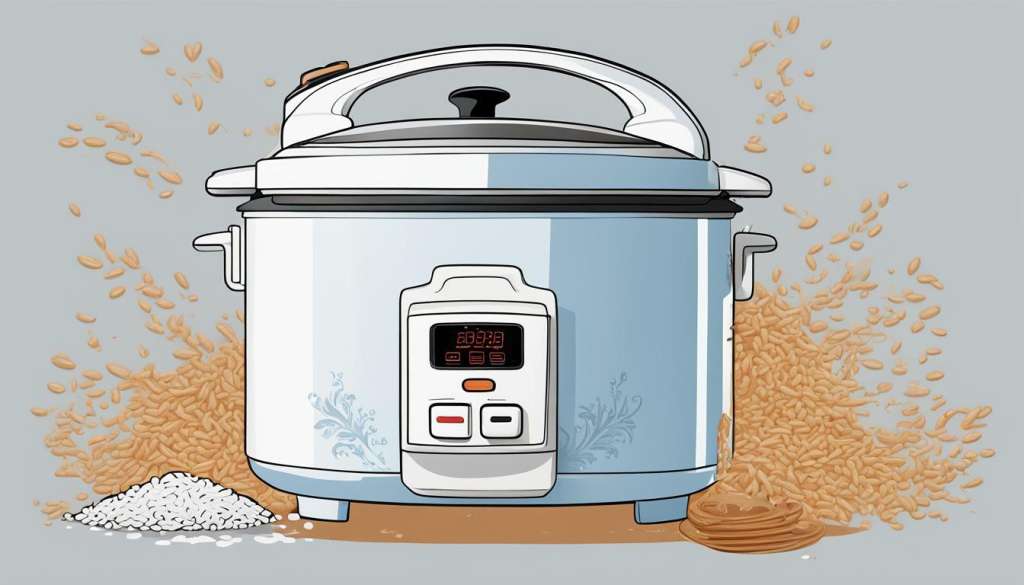
Conclusion
In summary, a rice cooker is indeed supposed to bubble as it uses steam to cook rice. While the bubbling effect is normal, excessive boiling over or foaming may indicate a problem and can be prevented with proper water levels and stirring.
To ensure the best results when using a rice cooker, it is important to follow proper maintenance and cleaning procedures, adjust cooking times for different types of rice, and utilize the various accessories and features available. Additionally, it is crucial to always prioritize safety by handling hot surfaces with care and following electrical safety guidelines.
When choosing a rice cooker, consider factors such as capacity, cooking functions, and budget to make an informed decision. By following these tips and tricks, you can achieve perfectly cooked rice and even use your rice cooker for a variety of other recipes.
Investing in a rice cooker can greatly simplify the cooking process and produce delicious results. Whether you’re a seasoned pro or just starting out, a rice cooker is a great addition to any kitchen.
FAQ
Q: Is a Rice Cooker Supposed to Bubble?
A: Yes, it is normal for a rice cooker to bubble during the cooking process. The bubbling is caused by the boiling of the water and steam that helps cook the rice to perfection.
Q: How Does a Rice Cooker Work?
A: A rice cooker works by using steam to cook rice. It has a built-in heating element that heats up the water in the cooker, creating steam. The steam then circulates around the rice, cooking it evenly. The rice cooker also has sensors to monitor the water level and adjust the cooking time accordingly.
Q: Is the Bubble Effect Normal or Indicative of a Problem?
A: The bubbling effect in a rice cooker is normal and not indicative of a problem. However, if the rice cooker is boiling over or foaming excessively, it may indicate an issue. In such cases, it is recommended to reduce the water level or check for any blockages in the vent.
Q: What Are Some Common Issues with Rice Cookers?
A: Common issues with rice cookers include rice sticking to the bottom, uneven cooking, or the cooker not turning on. To troubleshoot these problems, you can try adjusting the water-to-rice ratio, cleaning the cooker thoroughly, or checking the power supply and settings.
Q: How Do I Maintain a Rice Cooker?
A: To maintain a rice cooker, it is important to regularly clean the inner pot and other removable parts. Descaling the cooker periodically can help remove any mineral deposits. It is also recommended to store the rice cooker in a dry and clean environment when not in use.
Q: How Can I Achieve Perfectly Cooked Rice with a Rice Cooker?
A: To achieve perfectly cooked rice, it is essential to follow the recommended rice-to-water ratio specified in the rice cooker’s manual. Different types of rice may require slightly different ratios. Additionally, adjusting the cooking time and using the correct cooking setting for the type of rice can help achieve optimal results.
Q: What Accessories and Features Does a Rice Cooker Have?
A: Rice cookers can come with various accessories and features, such as steaming baskets for cooking vegetables or fish while the rice cooks, delay timers for presetting the cooking time, and automatic keep-warm settings to keep the rice warm after cooking.
Q: Can You Share Some Tips and Tricks for Using a Rice Cooker?
A: Certainly! In addition to cooking rice, a rice cooker can be used for preparing other dishes like oatmeal, quinoa, and even soups. You can get creative by adding herbs, spices, or vegetables to the cooking process to enhance the flavors. Experimenting with different types of rice and grains can also expand your culinary possibilities.
Q: How Do I Choose the Right Rice Cooker?
A: When choosing a rice cooker, consider factors such as the capacity you need, the cooking functions you desire (e.g., steaming, slow cooking), and your budget. It is also helpful to read reviews and compare different models to ensure you select the right one for your specific requirements.
Q: What Safety Precautions Should I Follow When Using a Rice Cooker?
A: When using a rice cooker, it is important to handle hot surfaces with caution, use oven mitts or potholders, and avoid direct contact with steam to prevent burns. Always follow the manufacturer’s instructions and guidelines for safe usage. Additionally, ensure proper electrical safety by plugging the rice cooker into a grounded outlet.


